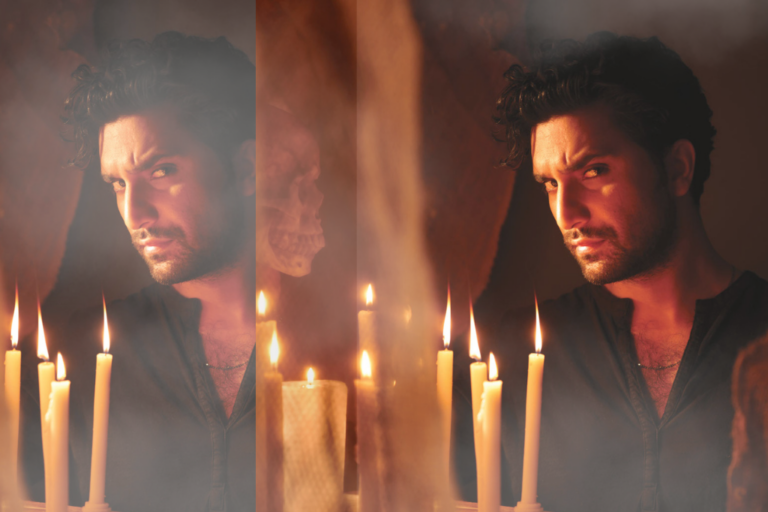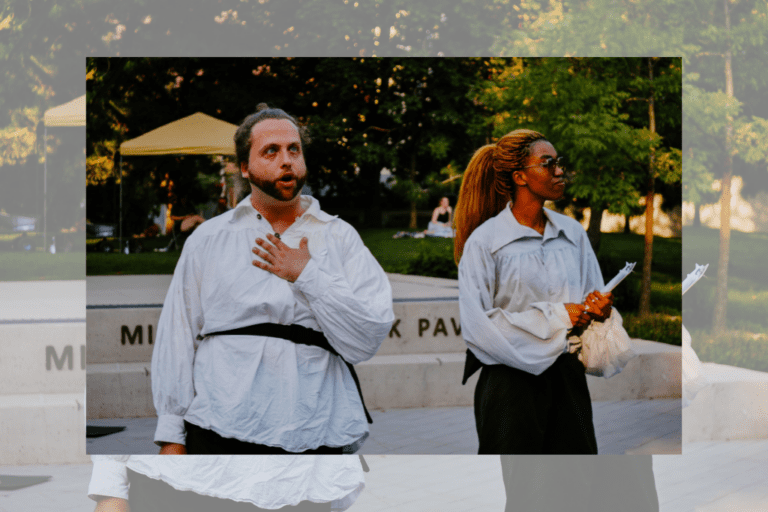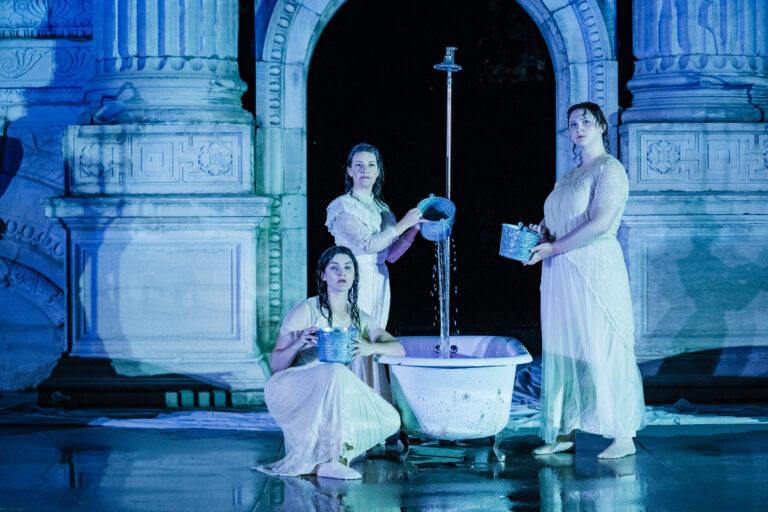REVIEW: Richard III at Stratford Festival
Richard, Duke of Gloucester certainly was right about one thing: this promises to be a glorious summer at the Stratford Festival.
Richard III is open at the festival’s Tom Patterson Theatre, and it seems to be a fitting debut for the new space: it is, after all, the very same play that opened the festival on July 13, 1953. Just as the inaugural production starred a legend of the stage and screen, Alec Guinness, the 2022 production features one of Canada’s most beloved actors and Stratford veteran, Colm Feore.
And Feore certainly is the focus of the show in the titular role of Richard, vengeful duke and soon-to-be tyrannical king. While I’ve long been told that Feore is a master of the bard’s language, it’s something you have to see to truly believe. He navigates the rhythm and metre of the text with incredible ease, nimbly weaving through complex monologues and rapid-fire exchanges without ever losing sight of the meaning behind the words. It’s a masterclass in classical acting, and an incredibly captivating experience.
Feore’s Richard is unlike any other I’ve seen before (I’ve seen this play more times than I’ll admit): he is calm, almost playful, which adds a delicious level of maliciousness that is often overlooked in favour of blatant anger and lust. When young Richard, Duke of York jumps on his uncle’s back for a piggyback in one scene, Gloucester entertains him for a moment, giving the audience a brief glimpse of unadulterated kindness: you start to actually like the villainous duke. The moment is undercut brilliantly when only seconds later, the Duke of Gloucester dumps the child from his back without breaking his smile, a vicious moment that is played with pure feigned innocence. It’s one of the most revealing moments of Feore’s Richard, and one of the only clear signs of his deep cruelty.
Indeed, although Feore commits admirably to the future king’s jarring, limping walk and extreme physicality, he never quite fully explores the depths of the character. While I appreciate that he doesn’t immediately resort to rage, the character’s fury and jealousy never fully shine through. The tyrant is more of a rat, almost Iago-esque in his portrayal, and on Sunday I found myself wishing for moments in which the true Richard would break through the facade.
The entire ensemble handles the complicated text beautifully, and despite my normal aversion to what I call “Shakespeare voice,” the affectation was consistent enough across the cast that it felt like a deliberate choice. Feore in particular could have convinced anyone that his mild British dialect was entirely natural (it was reminiscent of his work as Reginald Hargrave in The Umbrella Academy).
Alone in her unaffected delivery was Seana McKenna, who absolutely dominates the show in her turn as Queen Margaret. Dressed in black with feathery details on her shoulders, McKenna sweeps through the space with birdlike agility: in fact, everything from her costume to the minute movements of her head and the stiffness of her arms is reminiscent of a raven, a brilliant choice given the context and setting of the play. Just as England is doomed to fall once the ravens leave the Tower of London, Queen Margaret’s exit from the play signals the beginning of Richard’s undoing, and McKenna’s transformational portrayal of the beleaguered queen left me longing for more.
Equally impressive is André Sills in the role of the Duke of Buckingham, Richard’s sometimes friend and often foe. Sills has an undeniable stage presence, and the power he exudes in each scene is a joy to behold.
Jordin Hall and Jon de Leon’s executioners provide a welcome moment of levity in what is ultimately a bloody scene, and Michael Blake, playing George, Duke of Clarence, navigates the comedic moments of his death scene with ease. The physical comedy provided by the two bumbling executioners lands perfectly without affecting the tension of the scene, and Blake pulls off the impossible by keeping the moment grounded while accepting the comedy he’s facing.
Shakespeare’s histories are difficult plays to present, given the abundance of contextual information that makes up the plot, but artistic director Antoni Cimolino’s production pushes forward without hesitation. There are few pauses in the action, almost no scenes that drag — for a three hour play based on the complex history of the late fifteenth century and the end of the War of the Roses, the entire ensemble does an admirable job of keeping the audience invested in the action onstage.
The play opens in a parking lot in Leicester, a nod to the 2012 discovery of the bones of the actual Richard III. The short prologue (which, be warned, begins five minutes before the show’s advertised start time) is mostly silent, featuring workers exhuming the site, graffiti artists spraying cement walls, and a news crew reporting on the event. While the open gravesite provides Feore with the perfect opportunity for a grand entrance, seemingly climbing from the underworld as the modern era melts away around him, it isn’t immediately clear what the significance of the moment is — unless you know the context.
Despite being set in the 15th century, there are a few moments in which the production flips into modern times, the prologue being one of them. Even with Cimolini’s director’s notes in the program explaining the context of the parking lot, the five-minute modernized scene added to the top of the script doesn’t impact the action of the play, and the other moments of modernization happen so quickly they’re hard to fully grasp. In the first half of the show, a 15th century servant stumbles upon a modern graffiti artist, who dashes from the stage within seconds of his discovery, and the play ends with a modern sequence in which Henry Tudor, Earl of Richmond (Jamie Mac) and Princess Elizabeth (Hannah Wigglesworth) deliver a joint speech (originally one of Richmond’s monologues) dressed as what one can assume are approximations of Prince William and Princess Kate. The scene is abrupt and without context, and although it creates a nice bookend for a piece that begins and ends in modern times, it’s somewhat distracting, especially coming immediately after the incredibly tight and well-staged battle earlier in the scene.
Overall, the design of the show is excellent, though a few choices may leave some scratching their heads. Designer Francesca Callow has artfully displayed where allegiances lie through the colours of the costumes — the Woodville family and most of the York wear varying shades of red and gold, while those in mourning or aligned with Richard wear black and silver. The contrast is beautiful in the intricate 15th century-inspired costumes, though Lady Anne (played by Jessica B. Hill) wears an inexplicably not-15th-century-but-not-quite-modern mourning dress and hairstyle, which stick out in an otherwise era-appropriate scene. As the action continues and more and more people are killed or swayed to Richard’s side, we see the sea of black garb spreading like a disease across the stage, a fitting visual metaphor for Richard’s toxic influence.
The set, while fairly simple, is effective and easily adaptable for every scene and setting. A large platform at the end of the stage is able to extend into the space, and set pieces are whisked on and off stage quickly and seamlessly between scenes. During the aforementioned battle in Act V, scene iii, the actors drape the platform in white fabric, creating a tent that is visually stunning and later becomes an effective tool for Richard’s nightmares and the great battle that follows. The combination of Michael Walton’s lighting and John Gzowski’s sound creates a cohesive and utterly mesmerizing sense of chaos, and the tent transforms into two flags that engulf the action onstage in a sequence that can only be described as sensory overload, in the best way. It’s one of the most impressive battle scenes I’ve seen onstage, with almost two dozen actors fighting simultaneously in an intricately choreographed moment that is one of the highlights of the show.
My sole quibble with the production is some of the voiceover recordings used in the final scene of the play. As the ghosts of Richard’s victims emerge from the aisles and enter the tent where the king is concealed, their short monologues play through the audio system, rather than being delivered by the actors in the moment. It’s an interesting choice, but for me, the combination of the voiceover and the fact that the audience isn’t able to witness Richard’s torment removes much of the power of that moment. Although it’s visually interesting, I would have been more interested to see how the ghosts’ words affected the king as he sleeps (the text implies that the ghosts are in his nightmares). Similarly, Richard’s final speech is a voice recording, which again removes some of the power of the moment.
The brand-new Tom Patterson Theatre makes for a stunning playground for the actors fortunate enough to work on its stage. Despite being rather narrow at first glance, the extended thrust stage provides the ensemble with ample space to move throughout the production, and proximity to the audience creates a sense of intimacy that is rare for a play with such a large cast. And the seats! A cushion, a cushion, my kingdom for a cushion (that doesn’t compress my tailbone to the point where I remain hunched in my chair long after the show ends): the seats in the new theatre are plush, wide, and satisfyingly raked. From where I was seated, the acoustics in the space were wonderful (though it was quite easy to hear the actors moving about backstage, something the festival might want to be aware of moving forward), and the entire environment was a sensory wonder.
While I would recommend bringing layers, as the theatre was quite cold throughout the play, it was a magical experience to be able to see all of the action on the stage without any obstruction, a first for me in Canadian theatres.
Richard III runs at the new Tom Patterson theatre through October 30. Tickets are available here.















Comments